Removing traces of small scratches
1. If the scratch is superficial and does not affect the metal of the panel, it is extremely easy to repair. Lightly rub the scratched area with fine sanding paste to remove loose paint particles and wax. Rinse the treated surface with clean water.
2. Using a small brush, paint over the scratch with the paint used for the exterior coating of the surrounding body panels. Continue applying the paint layer by layer until the surface of the paint inside the scratch reaches the level of the surrounding surface of the panel. Allow the new paint to cure for at least two weeks, then sand the transition surface flush with the rest of the panel using a very fine sanding paste. Finally, coat the treated surface with wax.
3. If the scratch has penetrated the paint, reaching the metal of the panel and causing it to corrode, another repair technique should be used. Use a penknife to scrape off powdered rust from the scratch, then treat the surface with inhibitor paint to prevent future corrosion. With a rubber or nylon applicator, cover the treated damaged area with a glossy type putty. If necessary - which is especially useful when filling narrow scratches - the putty can be thinned with a solvent to form a very fine paste. Before the gloss putty hardens inside the scratch, wrap your fingertip with a smooth cotton cloth. Then, after soaking your finger in the solvent, quickly run it along the puttied surface of the scratch. This will make the surface slightly concave. Now, after the putty has hardened, the treated scratch can be painted.
Dent Repair
1. When repairing dents, the first task is to stretch the deformed surface in order to bring it to the level of the original. It makes no sense to try to achieve one hundred percent correspondence to the original - it is still impossible due to the violation of the internal structure of the panel metal upon impact. It is optimal to bring the level of the indented surface to a level approximately 3 mm below the surface of the surrounding undamaged area of the body panel. If the dent is very shallow, pulling it out does not make sense at all.
2. In the case when the concave area can be reached from the back side of the panel, you should try to straighten the dent from the inside by hitting a soft-faced hammer. When tapping a dent, press a wooden mallet firmly against the face of the dent to dampen the momentum of the blow to avoid excessive buckling of the deformed panel metal.
3. If a dent has formed on the two-layer section of the panel, or access to it from the back side is impossible for any other reason, a different pulling technique should be used. Drill a few small holes into the concave section of the panel, making sure that they are in the deepest areas of the dent. Then screw long self-tapping screws into the holes, leaving their heads sticking out just enough to grab onto with tongs. Now start pulling out the dent with tongs behind the screws.
4. The next step in treating the dent is to remove the paint from the damaged surface and an area approximately 3 cm wide around it. This work is best done with a wire nozzle or a sanding disc installed in an electric drill chuck, but manual sanding is no less effective. The final step in preparing for puttying is to scratch the exposed metal of the dent with a screwdriver or a piece of file, or drill small holes in it to ensure maximum adhesion of the putty to the metal surface. Then you can proceed to the implementation of the procedures of puttying and painting.
Repair of rusted holes and holes
1. Using an abrasive or wire tool clamped into the chuck of an electric drill, remove all traces of paint from the damaged area and in an area about 3 cm wide around it. In the absence of the possibility of using an electric drill, the work can be done no less efficiently by hand with sandpaper.
2. After removing the paint, you can assess the degree of damage to the metal by corrosion and decide whether it makes sense to start repairing or whether it would be more reasonable to replace the entire panel (if it is possible in principle). New panels can be purchased not as expensive as many motorists think. It is often much faster and even more economical to install a new panel than to repair extensive damage to the body.
3. Remove all body trim from the damaged panel, with the exception of those that can serve as a guide to recreate the original shape of the deformed areas (such as headlamp trim, etc.). Using metal shears or a hacksaw blade, remove all freely dangling, loosely fixed and hopelessly corroded pieces of metal, then bend the edges of the hole inward with a hammer to form a recess for putting putty material into it.
4. Use a wire brush to remove powdered rust from damaged metal. If there is access to the reverse side of the damaged area, treat it with a corrosion inhibitor.
5. Before starting puttying, the hole must be plugged. This can be done by riveting or screwing a piece of tin to the damaged area on the reverse side of it, or by covering the hole with wire mesh.
6. After blocking the hole, the damaged area can be puttied and painted.
Puttying and painting
1. There are many types of body fillers, however, it should be noted that for this type of work, the putty paste supplied with the body panel repair kits with a hardener placed in a tube is best suited for this type of work. In order to achieve a smooth and regular contour of the puttied surface, the paste must be applied with a flexible plastic or nylon applicator. Strictly following the manufacturer's instructions (violation of them can lead to improper hardening of the putty mass), knead a small amount of putty on a clean wooden or cardboard surface (use hardener carefully).
2. Use the applicator to apply putty to the properly prepared surface of the damaged area of the body panel. To achieve the desired surface contour and putty level, each stroke of the applicator should go through the entire surface to be repaired. As soon as the contour of the putty surface is close to the original, immediately stop applying the putty, as it, when cured, will begin to stick to the applicator, forming lumps and leaving scuff marks on the treated surface. Continue applying coats of paste at intervals of approximately 20 minutes until the level of the putty surface is slightly above the surrounding metal of the panel.
3. After the putty has hardened, the excess can be removed with a file. Next, the stage of sanding and grinding the puttied surface begins. Imported waterproof sandpaper is best suited for this purpose (since it maintains a uniform grain size of the abrasive and its good adhesion to the base). You should start with coarse paper No. 180 and, progressively reducing the grit, you can finish with No. 600. In order to achieve adequate flatness of the treated surface, the paper should first be wrapped around a block of dense rubber (wood or foam) or stick on it. During processing, the paper must be regularly and frequently wetted with water. This technology allows you to achieve absolute smoothness and evenness of the treated surface at the final stage.
4. At this point, the treated damaged surface should be surrounded by a ring of clean, bare metal, ending in a gradually fading edge of good paint. Rinse the treated surface with clean water, washing off all the abrasive formed during grinding.
5. From an aerosol can, spray the treated surface with a thin layer of a light primer. This will reveal all the defects made during grinding, which can be eliminated by covering them with a layer of fresh putty. Repeat the sanding and sanding step. Repeat alternating puttying, treatment and priming of the surface until a satisfactory result is obtained. When finished, rinse the treated surface with water and dry it.
6. The surface is now ready for painting. Aerosol painting of a car should be carried out in still, dry, warm, and dust-free air. The conditions of a volumetric closed and heated room most fully meet these requirements. If circumstances force you to paint the body outdoors, you should be very serious about choosing the right weather conditions. When working indoors, beat down the dust by spraying the floor with water. If only a single body panel of the vehicle is being painted, cover the undamaged panels surrounding it. This precaution will minimize the effect of slight differences in tones between old and fresh paint. Finishing elements such as chrome decorative strips, door handles, etc. should also be covered (better to take it off). To protect non-paintable surfaces, use adhesive tape and old newspapers, which should be applied in several layers.
7. Shake the can thoroughly before using the spray, then spray paint on a test surface, practicing the staining technique. Cover the surface prepared for painting with a thick layer of primer. The thickness should be achieved by repeatedly applying the primer in thin layers. Sparing no water, with moisture-resistant sandpaper No. 600, process the primed surface, achieving its absolute smoothness. Allow the primer to dry completely before proceeding with the final painting.
8. Apply a layer of decorative paint, again achieving thickness by applying it repeatedly. Start painting from the center of the area to be repaired, making circular movements with a spray can, expanding their radius in a spiral until the entire damaged area is covered, plus another ring of the surrounding good about five centimeters wide. After 10 - 15 minutes (better not later, so as not to damage the edge of the fresh paint starting to harden) after applying the last coat of paint, peel off the newspapers and adhesive tape that covered the surrounding body panels. The paint cures completely within about two weeks, after which, to smooth the transition of fresh paint, treat the restored surface with a very fine sanding paste. Finally, apply a layer of wax to the panel.
These photographs illustrate the method for repairing simple dents. They belong to the section "Repair of minor body damage" of this Chapter and cannot be used as the only manual for the repair of the car body of this model.
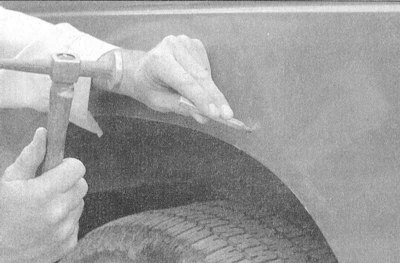
1. If there is no access to the rear side of the body panel to knock out the dent, it should be pulled out with a sliding hammer. At the deepest point of the dent, or along the edge of the dent, drill or hammer small holes at least 2.5 cm apart.
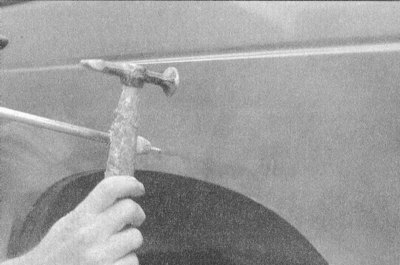
2. Then screw the hammer shaft into the hole and actuate it. Tap the edge of the dent with a mallet to help the metal return to its original shape. After completing this procedure, the surface of the dent should approach its original contour and protrude approximately 0.3 cm above the surface of the surrounding metal.
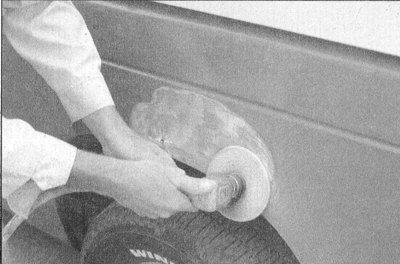
3. Using coarse sandpaper, remove the paint to bare metal. You can do it by hand, but the tool shown in the photo will help you speed up the process. Using a finer, approx. 320 grit sandpaper, wipe away the paint within a radius of at least 2.5 cm around the dent area.

4. After removing the paint, it is better to check by touch than by sight whether the metal surface is sufficiently even. Hammer out the bulges and/or pull out the cavities where necessary. Clean the surface to be restored with a wax or silicone stain remover.
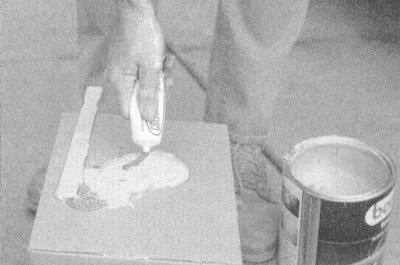
5. Following the instructions on the package, mix the pack of plastic putty with the hardener. The mixing ratio is critical, and if you break it, the putty will harden too slowly or too quickly (and you will not have time to apply it and give the desired shape).
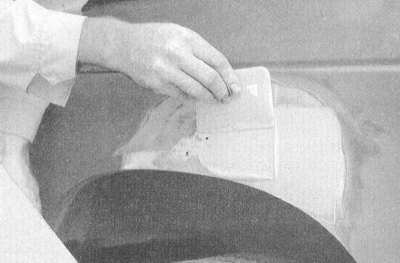
6. Working quickly to prevent the putty from curing, use the plastic applicator to apply it with pressure to the metal surface, making sure it fully engages with the metal. Treat the putty so that it takes a shape close to the original shape of the site and slightly rises above the surrounding surface.
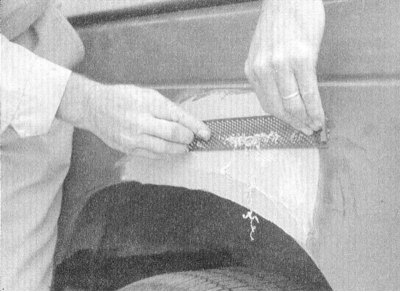
7. Let the putty harden to such a state that it can only be pushed through with a fingernail. Using the file or tool shown in the photo, roughen the putty.
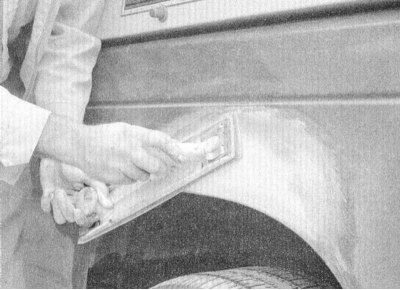
8. Using coarse sandpaper, mounted on a plank or bar, process the putty so that it becomes smooth and even. Gradually move to thinner and thinner grades of paper, always using a plank or block, and finish with number 360 or 4009.
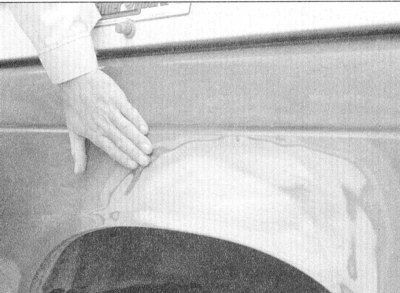
9. As a result of processing, the hand should not feel the boundaries of the transition from putty to bare metal and from bare metal to old paint. If this goal is achieved, remove dust and cover adjacent panels and trim.
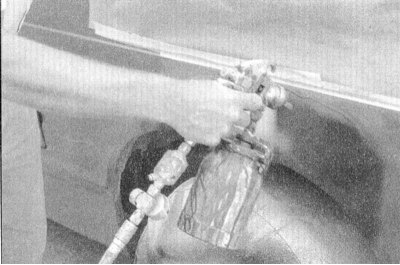
10. Apply several coats of primer to the surface to be treated. Don't overspray the primer so it doesn't run off, and after applying each coat, let the previous one dry. Usually a professional spray gun is used here, but auto parts stores have a primer in an inexpensive aerosol can.
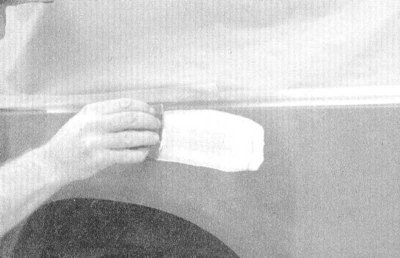
11. The primer will help to reveal defects or scratches. Fill them with polishing paste. Following the instructions on the package, process it with a thin (No. 360 or 400) sandpaper until smooth. Repeat polishing by applying polishing paste and sanding until the primed surface is completely smooth.
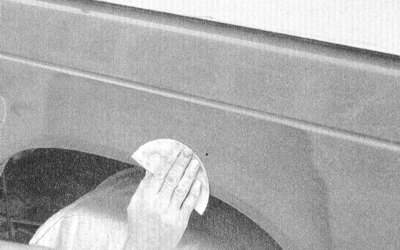
12. Finish sanding with very thin paper (No. 400 or 600), to remove excess primer. Wash the treated area with water and let it dry. Use a sticky cloth to completely remove dust, then apply a coat of exterior paint. Do not attempt to wipe or wax the area until the paint is completely dry (at least two weeks).